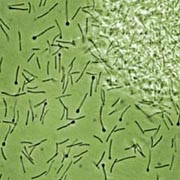Massachussetts-based startup Qteros announced details of a new partnership that is expected to broaden its range of potential feedstocks and reduce production costs for cellulosic ethanol. Qteros and Israeli commodities recycler Applied CleanTech (ACT) entered a joint development project that the companies claim is the first to demonstrate the commercial viability of making ethanol from liquid municipal waste.
 Qteros CEO Bill Frey said the agreement is not exclusive, and the pair doesn’t plan to build ethanol plants. Instead, Qteros and ACT could agree to license the technologies to municipal wastewater treatment plants, or to third-party developers. “We’ve been able to show the flexibility that the technology has in adapting to multiple types of feedstocks,” Frey said. “The real value of the technology is that it’s the lowest cost, non-food technology available.” Length and financial terms of the project weren’t disclosed, but the companies received a grant for an undisclosed amount from the Binational Industrial Research and Development (BIRD) Foundation, which funds joint efforts between Israel and the United States.
Qteros CEO Bill Frey said the agreement is not exclusive, and the pair doesn’t plan to build ethanol plants. Instead, Qteros and ACT could agree to license the technologies to municipal wastewater treatment plants, or to third-party developers. “We’ve been able to show the flexibility that the technology has in adapting to multiple types of feedstocks,” Frey said. “The real value of the technology is that it’s the lowest cost, non-food technology available.” Length and financial terms of the project weren’t disclosed, but the companies received a grant for an undisclosed amount from the Binational Industrial Research and Development (BIRD) Foundation, which funds joint efforts between Israel and the United States.
The liquid-waste treatment process at municipal wastewater plants typically has leftover material that must be disposed of. ACT’s technology extracts certain materials from the waste, including cellulose and oil, and creates solid pellets. ACT says those pellets could potentially be combusted to produce electricity, used as pulp to produce paper, and used as feedstock for ethanol.
However, Frey said, ACT lacked a process to use those pellets to produce ethanol. “There was not a technology that anyone had available to actually convert that material into ethanol,” Frey said. “What we’ve done is develop our process so that it can use this particular source of cellulosic material.”
Qteros, formerly known as SunEthanol, uses microbes to convert cellulosic material into ethanol in a single-step process that takes about four days. Qteros’ process has used fast-growing grasses, corn stover, sugarcane bagasse, wheat straw, and woody biomass such as poplar, Frey said. “We wanted to challenge our technology with as many feedstocks as possible,” he said.
ACT said each ton of its solids-based material, trademarked as Recyllose, can produce 120 to 135 gallons of ethanol. ACT didn’t disclose the amount of wastewater needed to make a ton of Recyllose but said a wastewater treatment plant that handles 150 million gallons a day, equivalent to a population of about 2 million, would produce enough Recyllose to supply a small-scale ethanol plant of about 5 million to 10 million gallons per year.
Qteros said Recyllose is low in lingin, which can improve the efficiency of the conversion to ethanol. In addition to ethanol production, ACT said the technology reduces the amount of wastewater that must be treated, which lowers costs and increases capacity. The companies plan to market the sludge-to-ethanol systems to municipalities as a cost-saving and money-making opportunity.
“Most have a cost associated with getting rid of the remaining material, so this would help them alleviate the costs they currently incur,” Frey said. “A lot of ethanol is made in a part of the United States that’s less populated, and it has to be transported to centers of population, which is where most liquid waste treatment centers are as well.” The U.S. Congress has mandated that, by 2022, 36 billion gallons of biofuel be blended into the fuel supply, including 16 billion of cellulosic ethanol and no more than 15 billion of corn ethanol.
Source
Qteros, press release, 2009-10-11.
Supplier
Applied CleanTech (ACT)
Binational Industrial Research and Development (BIRD) Foundation
Qteros
Share
Renewable Carbon News – Daily Newsletter
Subscribe to our daily email newsletter – the world's leading newsletter on renewable materials and chemicals













